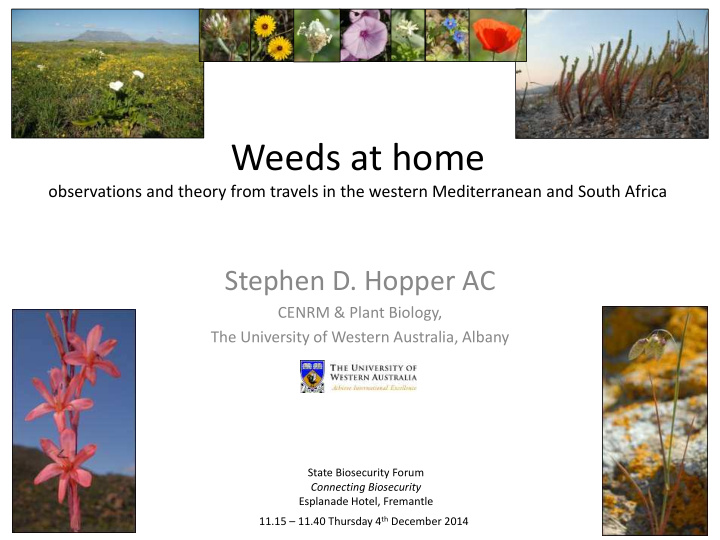



Weeds at home observations and theory from travels in the western Mediterranean and South Africa Stephen D. Hopper AC CENRM & Plant Biology, The University of Western Australia, Albany State Biosecurity Forum Connecting Biosecurity Esplanade Hotel, Fremantle 11.15 – 11.40 Thursday 4 th December 2014
Abstract OUTLINE • Regions of Australia experiencing a Mediterranean climate have exceptional numbers of , and vulnerability to invasion from, weeds . • Weeds may be rare in their native range due to natural checks on population growth. • However, developing a predictive framework around the population biology and invasive potential of weeds remains fraught . • Each species may have different herbivore/pathogen relationships, and respond differently to climate change, a predictable observation of idiosyncratic behaviour , as seen from the context of Darwinian evolutionary biology. • This presentation offers a review of recent field studies and development of theory pertinent to the southern Australian weed flora .
November 2013 | Volume 8 | Issue 11 | e79174 naturalized species
SWAFR and its naturalized flora are exceptional among Mediterranean Climate Regions • Highest weed species and generic richness (mainly Poaceae, Asteraceae, Fabaceae) • Highest naturalized species density • Iridaceae in highest numbers • Not correlated with geographic and landscape heterogeneity, nor exceptional fire regimes • Lowest human population and urban area, but greatest agricultural area • More OCBILs, less YODFELs (Hopper 2009) • Highest numbers from African and Eurasian origins • Broadest range of habitat types occupied, especially inland riparian and wetland woodlands, forests and tall dense shrublands Why? • Highest taxonomic similarity and homogeneity among species assemblages across habitats Tests? • Low natural stress (OCBILs) and highly disturbed habitats the most invaded Arianoutsou et al. 2013 PLOS ONE 8 (11); Hopper 2009 Plant and Soil 322, 49-86
South Africa’s west coast
Climatically: Cape Town = Esperance Bay (courtesy Dr J Scott, CSIRO)
Fallow fields and thicket – Senecio elegans, boxthorn & bitou
The rare Cape Weed
Granite outcrops – West Coast
Crassula natans
The lost world of renosterveld
Paardeberg flatrock
84 species of geophytes on Paardeberg flatrock
Veld grasses perennial and annual Ehrharta calycina Ehrharta longiflora
Cape mountains – rainforest and fynbos Asparagas, Dipogon and Psoralea
Gladiolus caryophyllaceus – critcally rare in Picketberg landscapes
Geophytes are often confined to rock outcrops – why?
Geophagy – eating underground storage organs Georychus capensis Bathyergus suillus Cryptomys damarensis Cryptomys h. pretoriae Cryptomys spp. Cryptomys h. natalensis
Reprieve from predation – enforced rarity
Las Negras Cabo de Gata-Nijar National Park
Climatically: Cabo de Gata-Nijar NP = Shark Bay (courtesy Dr J Scott, CSIRO)
Corsican and UK coasts
Inland Cabo de Gata-Nijar National Park
A sixth of WA weeds – 230 species – are native to Cabo de Gata-Nijar National Park (20% of the local flora) • The largest proportion recorded from any one park in the world. • Why? • Young (5-7 Ma), often-disturbed, fertile volcanic soils • 30% of CdGNP’s flora are annuals • Rich in Asteraceae, Fabaceae, Brassicaceae, Apiaceae, Poaceae, Scrophulariaceae, Euphorbiaceae
Granite flora – Serra de Guadarama N of Madrid
Southwest Australian Floristic Region From this to this – why? South Africa
Gingin cemetery – extreme sensitivity to topsoil removal and cessation of burning photos S.D. Hopper From this for decades ... weeds ... to this overnight
Why? The vital top 10cm of soil
Interactions of soil depth and weed invasion on germination of natives and weeds Fisher et al. 2009 Biological Conservation 142, 256-269 Invaded Good condition bushland bushland Keith Lightbody
Summary • Weeds may be rare in their native range – natural checks on population growth • Each species is idiosyncratic (predicted from Darwinian evolutionary theory) and may have different herbivore/pathogen relationships, and respond differently to climate change and habitat contingency • Weeds mainly evolve on young, often-disturbed fertile landscapes (YODFELs) • Exceptional vulnerability to weed invasion occurs on old climatically-buffered infertile landscapes (OCBILs) that endure major soil disturbance and fertilization • Early days – these hypotheses need rigorous critical experimentation and testing • WA needs biosecurity investment equivalent to its globally exceptional challenges with invasive weeds.
Recommend
More recommend